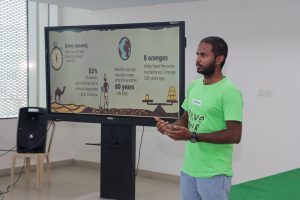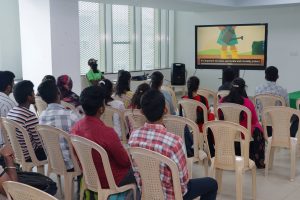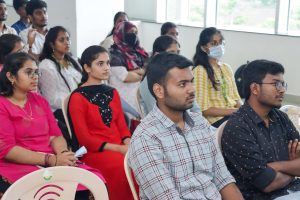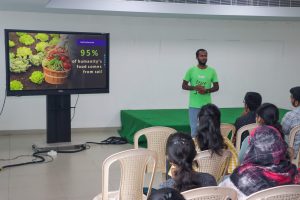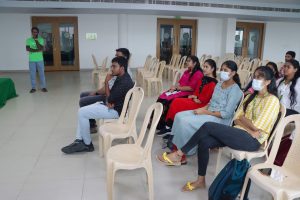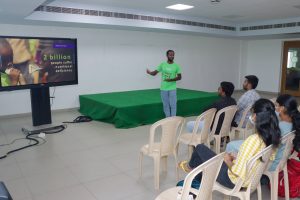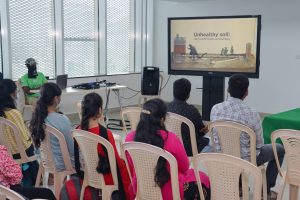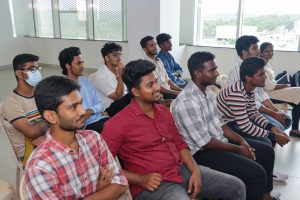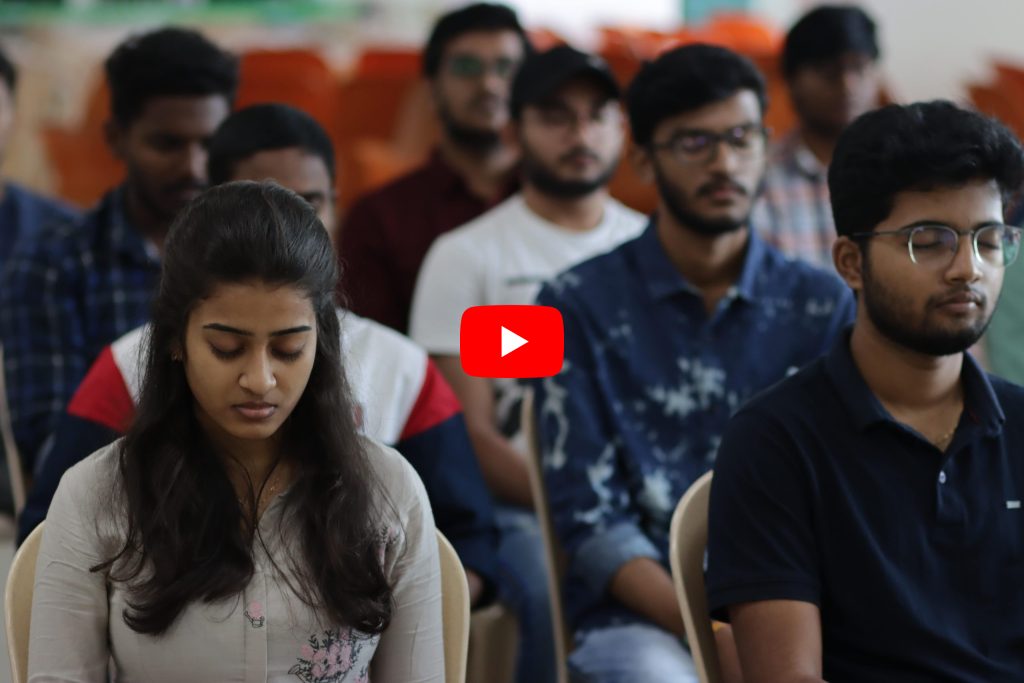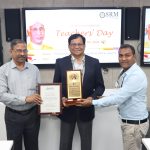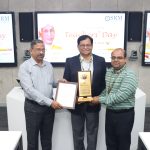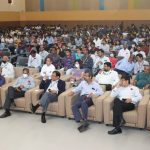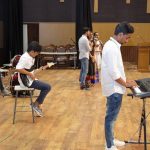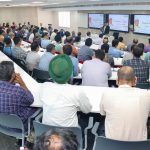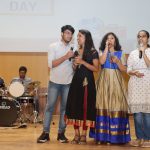SRM-AP All News
ALL News
- Security concerns in digital image transmission over the internet September 13, 2022
 The research team from the Department of Computer Science and Engineering proposes a research scheme to address security concerns in the transmission of digital images of aerial Remote sensing images over the Internet. Assistant Professor Dr Priyanka, Assistant Professor Dr Jatindra Kumar Dash, research scholar Ms K Jyothsna Devi, and BTech student Mr. M V Jayanth Krishna, published the paper A New Robust and Secure 3-Level Digital Image Watermarking Based on G-BAT Hybrid Optimization in the Mathematics Journal SCI, a Q1 Journal with an Impact Factor of 2.9. The research project combats various threats in the transmission of Remote sensing images, such as copyright protection, copy control, and unauthorized access.
The research team from the Department of Computer Science and Engineering proposes a research scheme to address security concerns in the transmission of digital images of aerial Remote sensing images over the Internet. Assistant Professor Dr Priyanka, Assistant Professor Dr Jatindra Kumar Dash, research scholar Ms K Jyothsna Devi, and BTech student Mr. M V Jayanth Krishna, published the paper A New Robust and Secure 3-Level Digital Image Watermarking Based on G-BAT Hybrid Optimization in the Mathematics Journal SCI, a Q1 Journal with an Impact Factor of 2.9. The research project combats various threats in the transmission of Remote sensing images, such as copyright protection, copy control, and unauthorized access.Abstract
This contribution applies tools from the information theory and soft computing (SC) paradigms to the embedding and extraction of watermarks in aerial remote sensing (RS) images to protect copyright. By the time 5G came along, Internet usage had already grown exponentially. Regarding copyright protection, the most important responsibility of the digital image watermarking (DIW) approach is to provide authentication and security for digital content. The main goal of the paper is to provide authentication and security to aerial RS images transmitted over the Internet by the proposal of a hybrid approach using both the redundant discrete wavelet transform (RDWT) and the singular value decomposition (SVD) schemes for DIW. Specifically, SC is adopted in this work for the numerical optimisation of critical parameters. Moreover, 1-level RDWT and SVD are applied to digital cover images and singular matrices of LH and HL sub-bands are selected for watermark embedding. Further selected singular matrices S LH and S HL are split into 3 × 3 non-overlapping blocks, and diagonal positions are used for watermark embedding. Three-level symmetric encryption with a low computational cost is used to ensure higher watermark security. A hybrid grasshopper–BAT (G- BAT) SC-based optimization algorithm is also proposed to achieve high-quality DIW outcomes, and a broad comparison against other methods in the state-of-the-art is provided. The experimental results have demonstrated that the proposal provides high levels of imperceptibility, robustness, embedding capacity, and security when dealing with DIW of aerial RS images, even higher than the state-of-the-art methods.
The proposed scheme is easily dumped into the sender and receiver machines to work readily. MATLAB platform is the only requirement. Researchers aspire to design new image watermarking schemes using machine learning and deep learning techniques. For this project, they have collaborated with Professor José Santamaría from the Department of Computer Science, University of Jaén, and Professor Antonio Romero-Manchado from the Department of Cartographic Engineering, Geodesy, and Photogrammetry, University of Jaén.
Continue reading → - Save the Soil workshop in collaboration with Isha Foundation September 13, 2022
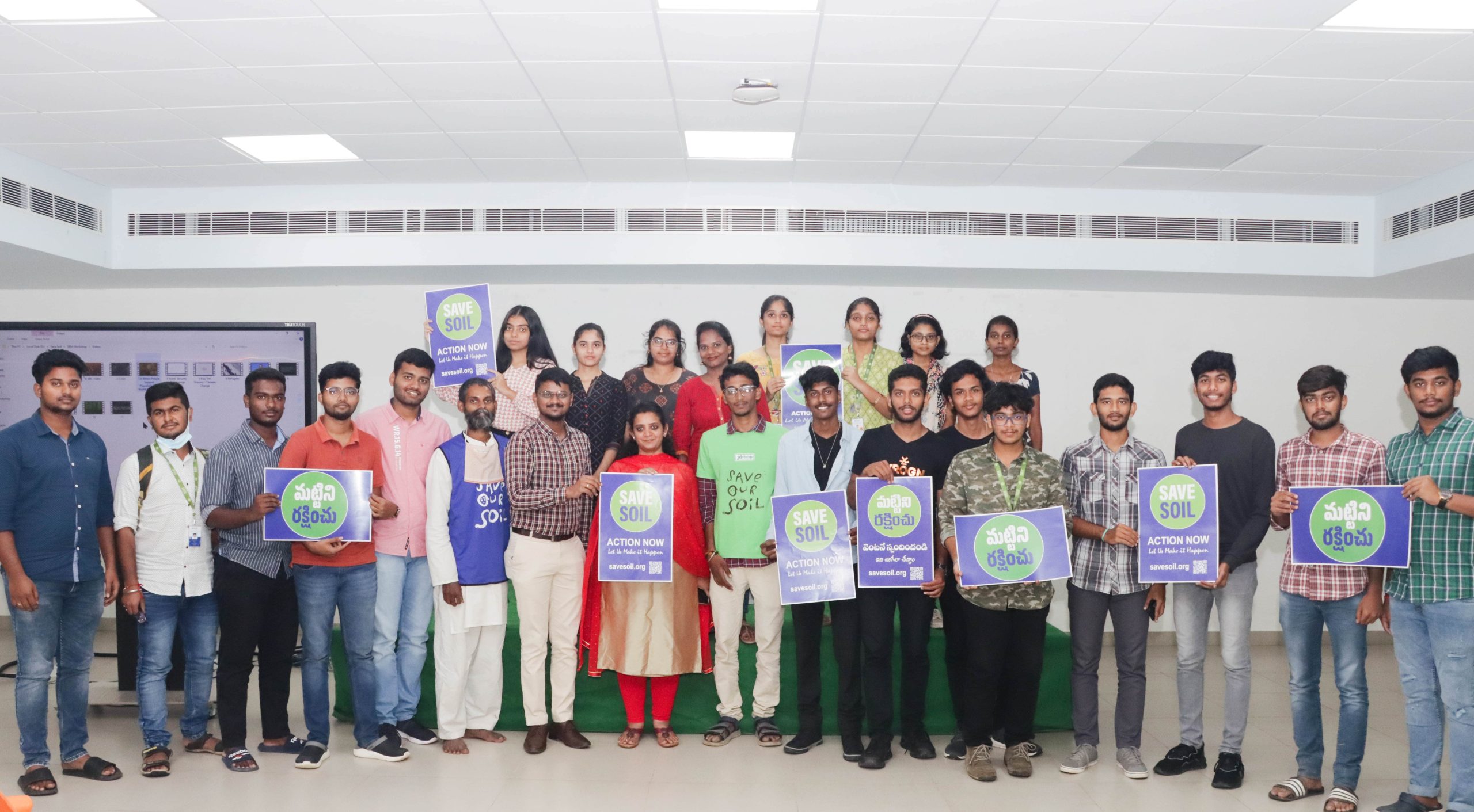
The Office of International Relations and Higher Studies in collaboration with Isha Foundation conducted a workshop “Save the Soil” for the students of SRM University-AP. The workshop intended to create awareness among the student community on the necessity of soil conservation. The Save Soil Movement is a global campaign spearheaded by the visionary, Sadhguru, to address the soil crisis and take a pioneering initiative towards the restoration of the planet.
As part of the workshop, students were given awareness classes and lectures on soil conservation and the deteriorating scenario of nature such as agricultural degradation, land pollution and soil erosion. An elaborate overview on the extensive damage inflicted on soil due to various human activities was discussed during the workshop. The soil extension and soil management ventures initiated recently brought attention to the degrading status of soil health due to excessive carbon footprint.
Students were also introduced to numerous techniques to improve the soil condition and reinstitute its fertility. The Save Soil movement advocates traditional conservation practices such as crop rotation, contour farming, conservation tillage etc., to retain and enhance the organic content of soil. The movement aims at establishing long-term policies that give special emphasis to addressing the soil crisis by uniting people, associations, and governments on a global scale. Raising awareness among students is the need of the hour to give rise to a conscientious generation capable of instigating a preservative outlook towards nature unlike in the past.
Around 60 students from different departments attended the three-day workshop that was held on September 05, 06, and 09. The Senior Programme Coordinator, Mr Sandeep Samala, encouraged the students to be part of the Save Soil campaign by registering on the portal. Dr Naga Swetha Pasupuleti, Associate Director, appreciated the Save the Soil – Isha volunteers for successfully conducting the workshop.
Continue reading → - Kick-starting placement 2023 with Marquee offers upto ₹26.50 LPA September 12, 2022
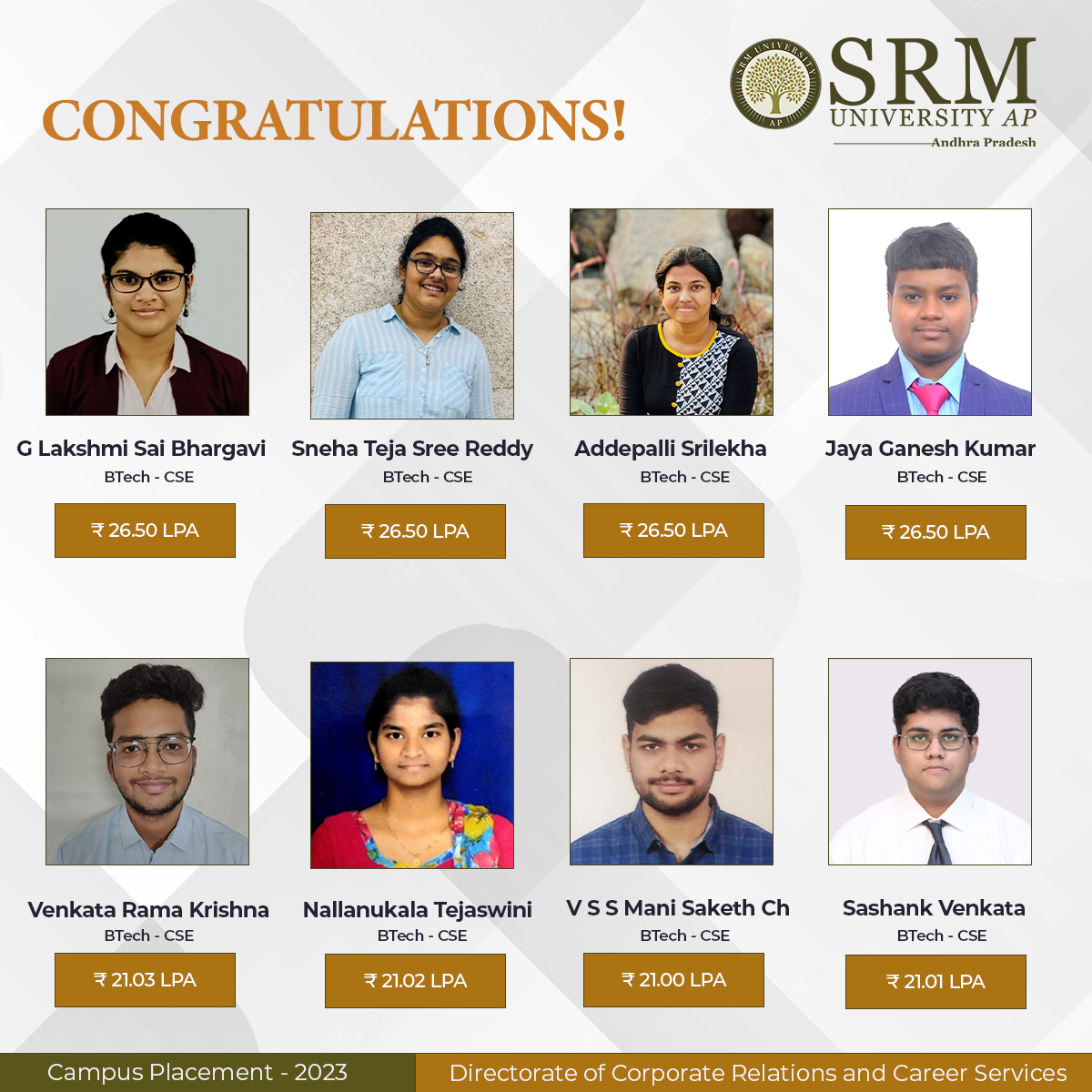 The Engineering students of SRM University-AP never failed to excel in the competitive placement drives with their unrivalled fervour. The Department of Computer Science and Engineering students are beyond thrilled about their placement with Marquee offers up to ₹26.50 LPA. G Lakshmi Sai Bhargavi, Sneha Teja Sree Reddy Thondapu, Addepalli Srilekha, Jaya Ganesh Kumar Gudipati, V S S Mani Saketh CH, Sashank Venkata Challapalli, Nallanukala Tejaswini, and Satti Venkata Rama grabbed marquee offers with incredible salary packages.
The Engineering students of SRM University-AP never failed to excel in the competitive placement drives with their unrivalled fervour. The Department of Computer Science and Engineering students are beyond thrilled about their placement with Marquee offers up to ₹26.50 LPA. G Lakshmi Sai Bhargavi, Sneha Teja Sree Reddy Thondapu, Addepalli Srilekha, Jaya Ganesh Kumar Gudipati, V S S Mani Saketh CH, Sashank Venkata Challapalli, Nallanukala Tejaswini, and Satti Venkata Rama grabbed marquee offers with incredible salary packages.The placement team of the university considers and analyses major recruiting companies’ criteria to equip our students to meet the various levels of constantly transforming industry demands. Students are instructed and trained from the very beginning of their programmes to know the pulse and challenges of the tomorrow they are exposed to. “The Placement team helped me a lot by introducing many Marquee companies at the beginning of academic years, which made me work faster on my skills”, says Mani Saketh with gratitude. “The way they helped us by conducting constant training sessions and responding very quickly whenever we had a single doubt or concern is commendable”, he added.
Making students industry-ready has always been a significant concern of the university. The courses provided in the university are supported not only by soft skill training but also by professional training. “There is always the possibility of starting from scratch here. Daily technical assessments helped us understand the industrial standards and requirements”, said Srilekha as she recollected her training days.
The Directorate of Corporate Relations and Career Services firmly believes that the latest placement offers marks just the beginning of the 2023 placements. Year after year, there is a considerable increase in the number of students recruited from the university. The placement team expects much more quality offers in the new placement season.
Continue reading → - Defect detection algorithms September 9, 2022
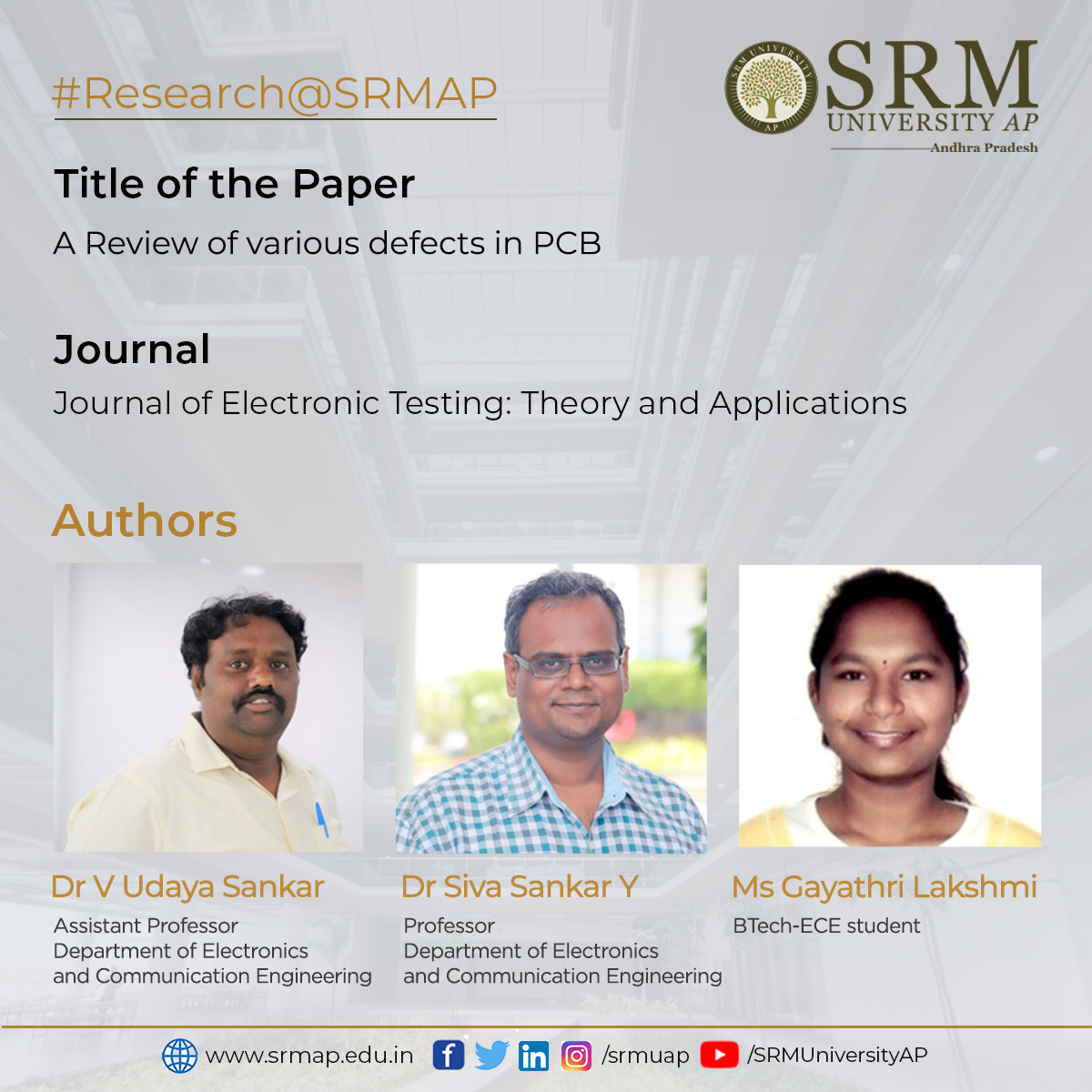 Research at the Department of Electronics and Communication Engineering is currently developing defect detection algorithms. Assistant Professor Dr V Udaya Sankar, Professor Dr Yellampalli Siva Sankar, and their BTech student Ms Gayathri Lakshmi have published a paper, A Review of various defects in PCB, in the Journal of Electronic Testing: Theory and Applications with an impact factor of 0.795.
Research at the Department of Electronics and Communication Engineering is currently developing defect detection algorithms. Assistant Professor Dr V Udaya Sankar, Professor Dr Yellampalli Siva Sankar, and their BTech student Ms Gayathri Lakshmi have published a paper, A Review of various defects in PCB, in the Journal of Electronic Testing: Theory and Applications with an impact factor of 0.795.Abstract
Printed Circuit Boards (PCBs) are the building blocks for all electronic products. Fabrication of a PCB involves various mechanical and chemical processes. As obtaining accuracy in the mechanical and chemical processes is very difficult, various defects/faults are formed during PCBs fabrication. These fabrication defects lead to performance degradation of electronic products. This paper describes multiple defects present in PCBs under the Through-hole and SMD categories. To understand the frequency of occurrence and reason for defects in both manual and machine, PCB fabrication data was collected and analysed from April 2017 to July 2020 as a part of industry collaboration.
The research is a review done on the defects present in PCB. Researchers surveyed various papers on PCB defects and their detection. Based on the literature review and information obtained from Efftronics systems Pvt. Ltd, they classified the defects, gave a detailed explanation for each, and provided some analysis of their occurrences.
While doing the literature review, researchers observed that no paper mentioned all the defects that can occur in the case of PCB fabrication. For this reason, they came up with this paper which provides detailed information regarding the defects. Information is also obtained from the industry. Comparing the defects can help focus on the critical defects for future research on defect detection methodology.
The project is done in collaboration with Efftronics Systems Pvt. Ltd. Through the partnership, the company supported sharing images, insights information related to defects and involved in discussions. Also, the company allowed visiting their premises to understand more about PCB defects. Researchers look forward to creating a prototype that detects all the defects mentioned in this paper for a given PCB.
Continue reading → - Studying the critical behaviour in physical systems through inequality analysis September 9, 2022
Dr Soumyajyoti Biswas, Assistant Professor from the Department of Physics, has been keenly involved in intense research around areas like the statistical physics of fracture and breakdown in disordered materials and machine learning methods in predicting the imminent breakdown in disordered systems. He has recently published two articles titled “Success of social inequality measures in predicting critical or failure points in some models of physical systems” and “Evolutionary Dynamics of Social Inequality and Coincidence of Gini and Kolkata indices under Unrestricted Competition” in the journals Frontiers in Physics and International Journal of Modern Physics C respectively. The research was done in collaboration with various academicians and undergraduate students (BTech CSE and BSc Physics) from the Indian Statistical Institute, Kolkata and Saha Institute of Nuclear Physics, Kolkata.
It is known that physical systems behave erratically near critical points. Since the 1970s, the ‘erratic’ behaviour has been explained in terms of critical phenomena, and it was found that there are some robust patterns in classes of systems, e.g., all liquid-gas transitions have something in common. Those common patterns were quantified in terms of critical exponents – some numbers that belong to a particular class of systems.
The research shows that if the ‘erratic’ responses of systems near critical points are quantified by some measures of inequality indices (higher the values of the indices, higher the inequality), then such indices behave in a near-universal way for different physical systems, even if they belong in different universality classes. The articles have shown such behaviour in models of physical systems. They have also shown that in socio-economic data, which are also the systems that were conjectured to be in the self-organized critical state. The behaviour from real data matches very well with those from the model simulations.
The researchers have tested their observations from the model simulations to various socio-economic systems that were long conjectured to be in the state of self-organized criticality. Specifically, they have looked into the income inequalities in the US, inequality in citations of authors, inequality in income from movies, and inequality in fluctuations of Bitcoin markets. In all these systems, the participating agents compete among themselves without much external intervention.
In fact, the only system among these where there are some interventions is income inequality. They have shown that through data from the IRS in the US, that inequality has consistently grown in the 1980s till date and has been following the path predicted in our model simulations.
In future, they plan on continuing along this line of looking at critical behaviour in physical systems through inequality analysis. Particularly for the systems where the critical point can represent a catastrophic event (say, fracture) and it is important to quantify the distance from such a catastrophic point.
Abstract of the Research
In many physical systems, experimentally measurable quantities vary drastically near the critical point of such systems. For example, in liquids turning into gas, the densities fluctuate, similar fluctuations happen for magnetisation near critical temperature. We have shown that in systems where the critical point is self-organized i.e., the system reaches the critical point on its own, the unequal nature of their responses show nearly universal trends, even if the models belong to different universality class. This observation could then be used in physical and also socio-economic systems, to quantify their distance from critical point.

Continue reading → The right hand side figure illustrates the variation of the inequality indices and the circle indicates the critical point where the system is evolving towards. On the left hand side, the picture presents the same indices for income inequality in the US. It has been observed that the inequality has grown over the years and tending towards the saturation value (about 0.86) in a very similar way that is seen in models.
The right hand side figure illustrates the variation of the inequality indices and the circle indicates the critical point where the system is evolving towards. On the left hand side, the picture presents the same indices for income inequality in the US. It has been observed that the inequality has grown over the years and tending towards the saturation value (about 0.86) in a very similar way that is seen in models. - Studying the agricultural transformation in Southeast Asia September 8, 2022
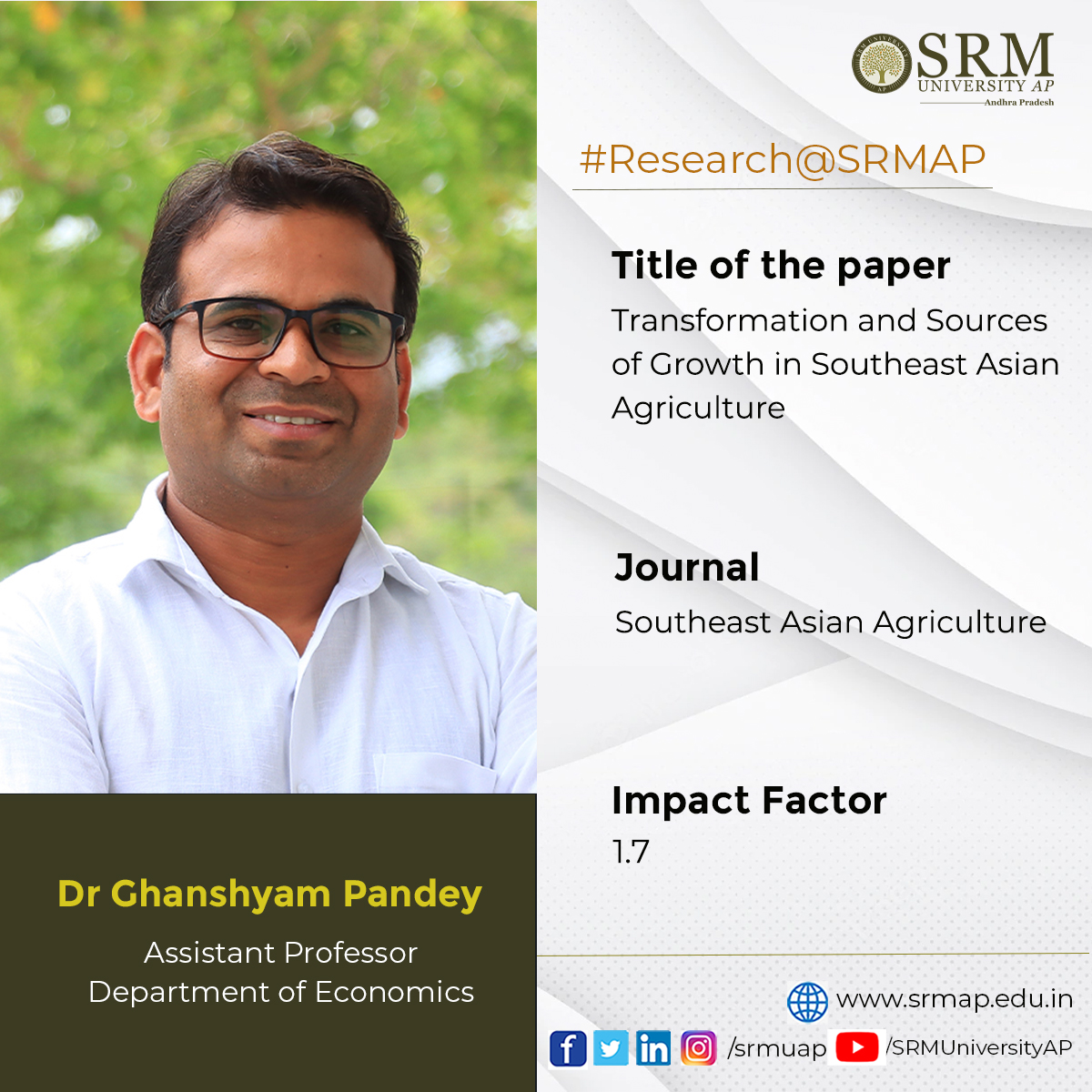
The promotion of sustainable growth of agriculture is one of the primary concerns of developing nations. The agriculture domain in Southeast Asia has undergone rapid transformation and structural changes over the last few years. Assistant Professor Dr Ghanshyam Pandey from the Department of Economics discusses the reasons for this changed scenario in his latest publication “Transformation and Sources of Growth in Southeast Asian Agriculture”. The research conducted in collaboration with International Food Policy Research (IFPRI) and the Indian Council of Agricultural Research (ICAR) was published in the Q2 journal Southeast Asian Agriculture having an Impact Factor of 1.7.
Abstract of the Research
Over the past few decades, agriculture in Southeast Asia has experienced robust growth and undergone a significant structural transformation, albeit at a different pace in different countries in the region. This paper aims to understand the agricultural transformation and growth process in Southeast Asia. The findings of this study show that driven by technological change, area expansion, and diversification, agriculture has grown faster in low-income countries in the region. In contrast, agricultural growth in high-income countries has been slow and driven by price increases, mainly of export-oriented commercial crops such as oil palm, rubber, and coconut—alongside an expansion of cropped areas under these crops. In view of the fixed supply of land and high volatility in global food prices, the area- and price-driven growth is not sustainable in the long run. For efficient, sustainable, and inclusive growth, exploiting the potential of existing and frontier technologies and diversification of production portfolios holds greater promise.
- Heartfulness Meditation Workshop September 8, 2022
The Office of International Relations and Higher Studies organised a four-day Meditation Workshop in collaboration with Heartfulness Meditation on August 26, 29, 30 and September 02, 2022, as part of the Aadigyan-Open Elective programme. The workshop introduced students to the basic lessons of the arts and science of meditation. Around 60 students participated in the training programme in 2 batches.
Hearfulness Meditation is a simple and subtle practice of meditation that connects an individual with the light and love of one’s heart. It follows the four basic steps – relax, meditate, rejuvenate, and connect – to guide oneself through a regulated path towards achieving tranquillity. Heartfulness is an essential life skill that would help one discover the sheer joy in existence.
The certified heartfulness trainers conducted sessions on the significance and essence of meditation. Students were made to practice meditation through guidance. The purpose of the programme was to develop inner strength and balance of mind to confront various challenges of life with poise and self-control. The workshop, through its premeditated pattern, will help students develop the habit of meditation and make it an integral part of their lifestyle.
- Onam celebration at its finest September 7, 2022
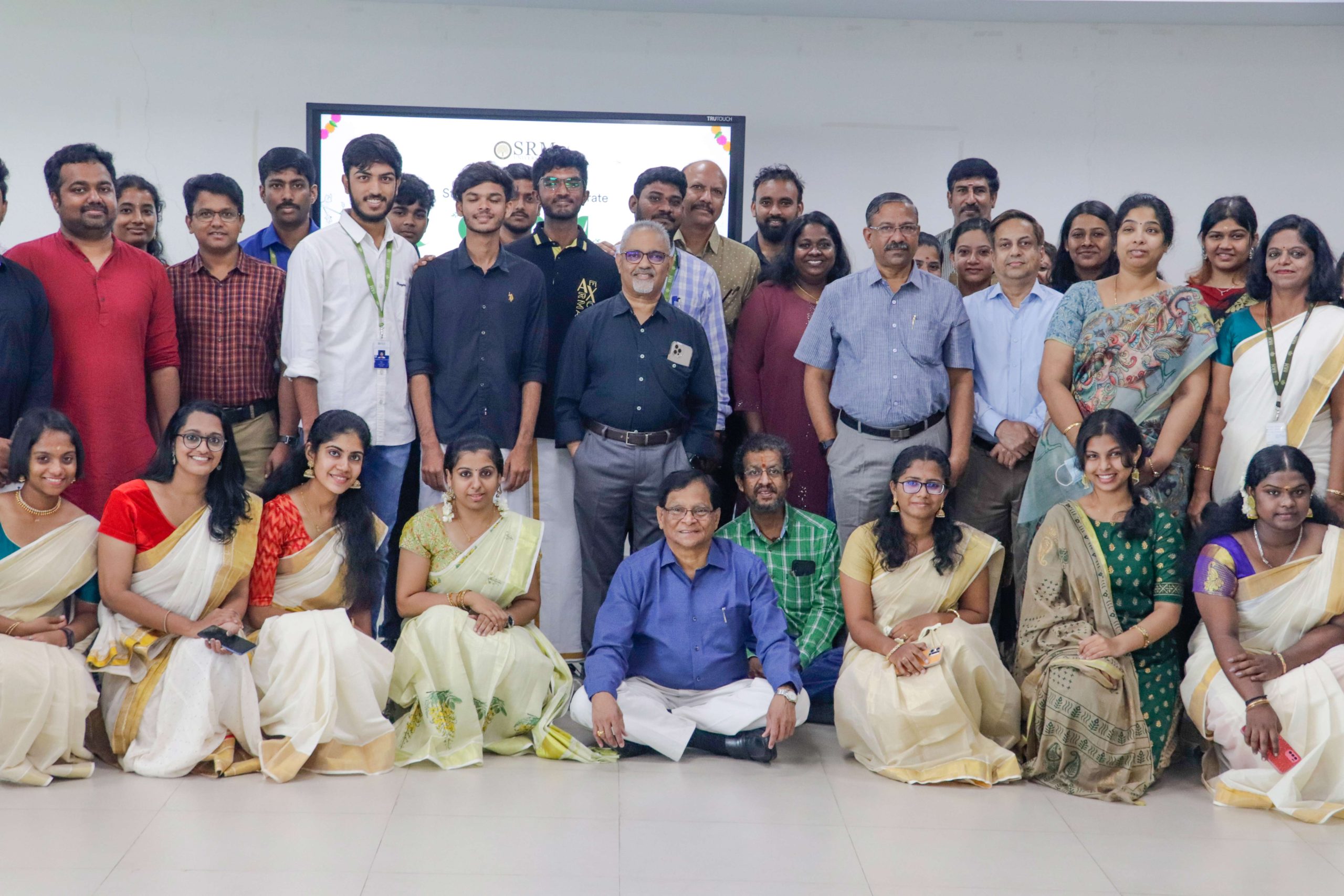 Onam is one of the grand festivals of Kerala, celebrated with ardent fervor by Malayalis all over the world every year for ten long days. Regional festivals are gaining a lot of attention beyond geographical boundaries as university campuses are getting more diverse. One of the many things that ignite the glory of SRM University- AP is the way it embraces different cultures with paramount importance. Students and Faculty of the institution got together in traditional attires on Wednesday to celebrate Onam, the harvest festival of Kerala, organised by the Department of Student Affairs.
Onam is one of the grand festivals of Kerala, celebrated with ardent fervor by Malayalis all over the world every year for ten long days. Regional festivals are gaining a lot of attention beyond geographical boundaries as university campuses are getting more diverse. One of the many things that ignite the glory of SRM University- AP is the way it embraces different cultures with paramount importance. Students and Faculty of the institution got together in traditional attires on Wednesday to celebrate Onam, the harvest festival of Kerala, organised by the Department of Student Affairs.Honorable Vice-Chancellor Prof V S Rao addressed the gathering and wished a prosperous Onam to the faculty and students. “It is an immense pleasure to celebrate Onam at a time when I am about to complete my 44 years of service in higher education”, said Prof V S Rao as he recollected his years of memories connected with Onam celebrations. Students were all ears when he described the historical scenario behind the celebration.
A large Pookkalam, welcomed students to the celebration. At the beginning of the event, a brief introduction to the historical and cultural significance of Onam was given by students. Energetic performances lifted the overall mood of the celebration. A video showcasing the exquisite aura of life in Kerala at the time of Onam was played. Payasam was distributed to all. The insights shared through the celebration for sure carved a beautiful memory of Onam in everyone.
Continue reading → - ROM 2022: Relay run of 487 km for child safety flagged off September 6, 2022
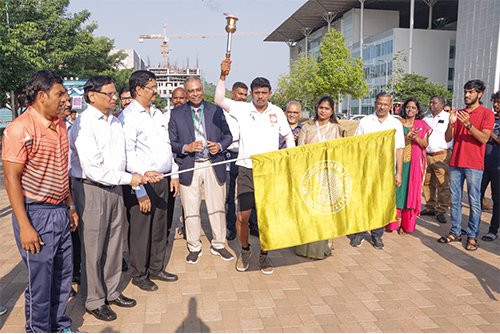 SRM University-AP flagged off a 487 km relay run with a flaming torch that will be concluded at SRM KTR campus on September 8, World Physiotherapy Day. “This group of 90 runners will set a record and inspire the people they meet on their way”, said Prof. K Hemachandra Reddy, Chairman, Andhra Pradesh State Council of Higher Education, igniting the torch that mirrors the Olympic torch.
SRM University-AP flagged off a 487 km relay run with a flaming torch that will be concluded at SRM KTR campus on September 8, World Physiotherapy Day. “This group of 90 runners will set a record and inspire the people they meet on their way”, said Prof. K Hemachandra Reddy, Chairman, Andhra Pradesh State Council of Higher Education, igniting the torch that mirrors the Olympic torch.SRM AP Vice-Chancellor Prof V S Rao expressed his delight to host the starting point of ROM (Resounding Overnight Momentous) 2022: THE PHYSIO RUN. “We are fortunate to be a part of making history by raising awareness for child safety and environment protection”, he added, flagging off the run. “The team spirit of these young runners is strong enough to bring out social changes”, said Professor Lt Col Arunachalam Ravikumar, Pro-Vice Chancellor, Medical & Health Sciences, appreciating the event. Dr T.S Veeragoudhaman, Dean, School of Physiotherapy, highlighted the functional independency that physiotherapy provides. Official Records Officer- World Records Union, Ms Shareefa, said that it is the responsibility of civilised citizens to promote national and community-level child protection systems.
Last year, the “Longest relay run with a flaming torch”, covering 280 km from the SRM Trichy campus to the SRM Kattankulathur campus, found a place in the Asia Book of Records and India Book of Records. This year, the torch that is lighted from the SRM AP campus will be passed on for 487 km until it is brought into the SRM Kattankulathur campus. The ignited torch carried onwards during the run will use the mother flame throughout the entire course until it reaches its destination and would not be extinguished at any given time or situation. The torch would only be kept alive with natural ingredients.
World Physiotherapy Day marks the unity and solidarity of the global physiotherapy community. SRM College of Physiotherapy and SRM Institute of Science and Technology Kattankulathur jointly organised this event to raise awareness on relevant issues like child safety, child disability and conservation of the environment. SRM AP Registrar Dr R Premkumar, Dean-School of Engineering and Sciences Prof B V Babu, Assistant Director- Student Affairs Ms Revathi Balakrishnan and many other dignitaries from SRM group institutions were present at the occasion.
Continue reading → - SRM University-AP celebrated Teachers’ Day 2022 September 6, 2022
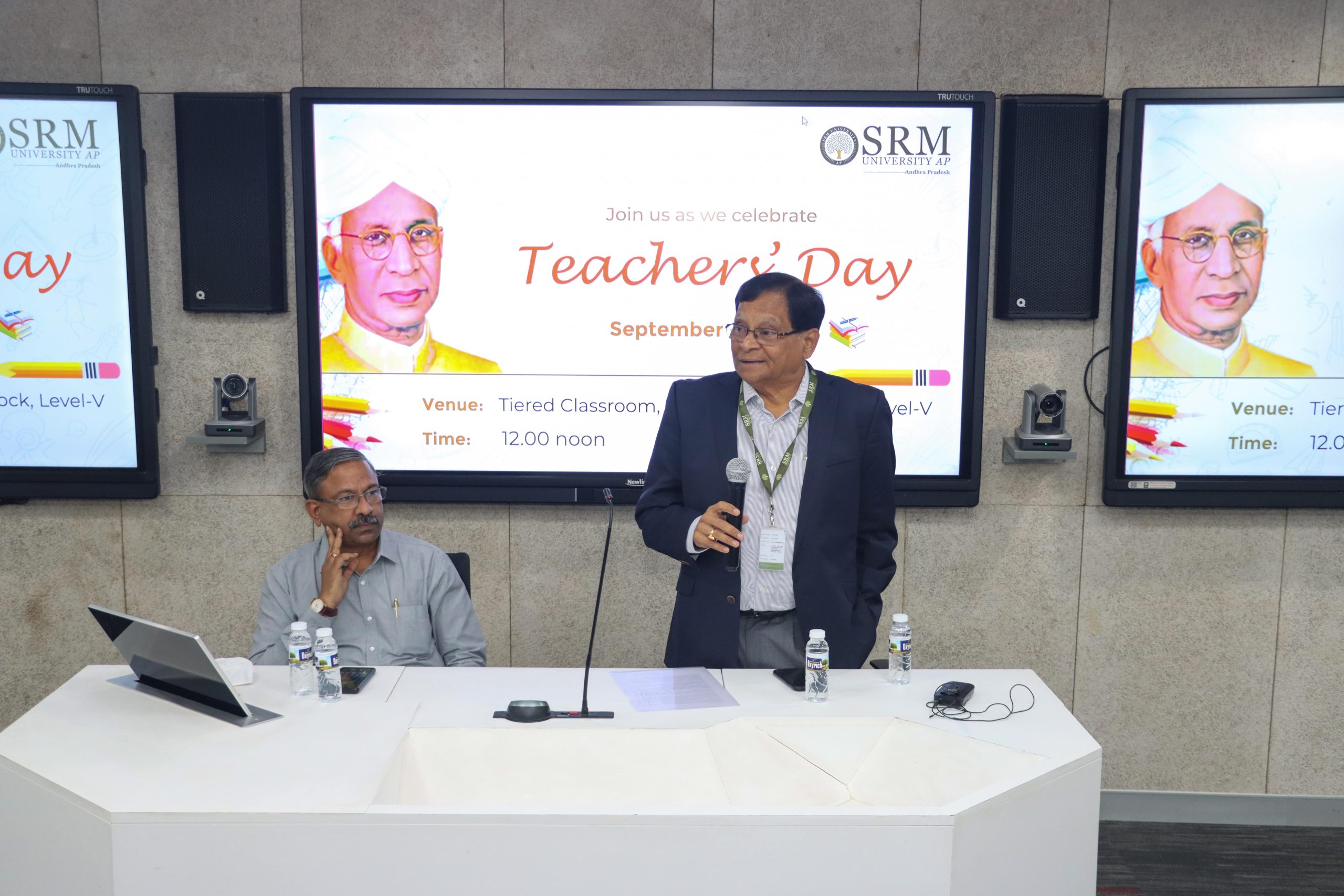
Teachers’ day is celebrated across the length and breadth of the nation on September 05, to honour and pay tributes to the second president of India, the renowned scholar and great philosopher, Dr S Radhakrishnan. SRM University-AP observed the day with utmost pride and the students marked gratitude to their beloved teachers.
Honourable Vice-Chancellor, Prof VS Rao, addressed the gathering of teachers and students. He reiterated the significance of the day and acknowledged the invaluable services of all faculty members. “I’m immensely proud of your achievements as educators and researchers. You have stood side by side with our children, led them with courage and passion, and believed in the prodigious potential of each of them. Your role in nurturing and growing them up is undeniable”, remarked Prof Rao.
A felicitation ceremony was organised to recognise the enormous contributions and extensive services rendered by the faculty who have been a part of SRM University-AP for the past five years. Mementoes were distributed, and the faculty were honoured by Vice-Chancellor Prof VS Rao and Registrar Dr R Premkumar. The teachers thanked the Vice-Chancellor and conveyed their admiration for his able guidance and the administration of the university for the last two years.
An array of cultural programmes and events was put up in the auditorium by the students to celebrate the day. Vice-Chancellor in his address to students appreciated their efforts in making the teachers’ day celebration a memorable occasion. With a colourful mix of dance and musical performances, the day was brought to a delightful closure.
Continue reading →


